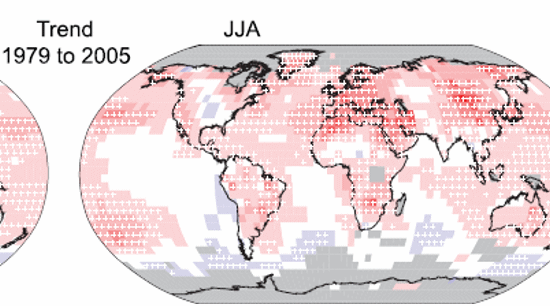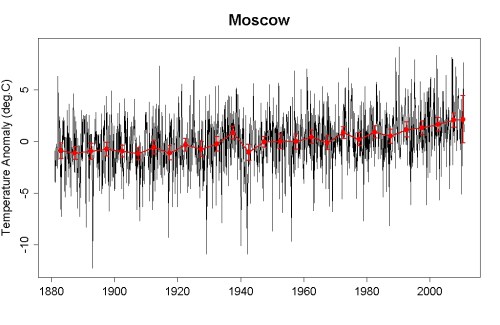Simulated frequency of occurrence of western Russia temperature extremes for 30-year overlapping periods. Shown are time series for exceedance values of 3, 4, 5 and 6o316 C…. Insert shows the time series for the number of models in [%] that simulate at least a 10% probability of occurrence of a heat wave with specific temperature exceedance values.
Apologies for leading with a complicated chart, but the NOAA release and study on the Russian heat wave last week buried the lede. All the news was about whether or not global warming caused the monster heat wave, but, as NCAR’s Kevin Trenberth explained to me about the paper, “Many statements are not justified and are actually irresponsible.”
First, the real news. The Russian heat wave was, according to NOAA, roughly 5°C ( 9°F) above average for July. The figure above shows that, using an ensemble of climate models, July temperatures will match that by the 2060s once a decade — twice a decade by century’s end. Remember, this 9F heat wave was enough to end Russian grain exports for a year. Note that a 4C (7F) warmer-than-average July would occur once a decade by 2040.
Moreover, the authors based their simulations on the A1B emission scenario. In 2100, A1B hits about 700 ppm with average global temperatures “only” about 3°C (5 F) warmer than today. In fact, on our current emissions path, a 3C temperature rise will likely happen much sooner (see M.I.T. doubles its 2095 warming projection to 10°F — with 866 ppm and Arctic warming of 20°F). Thus, the monster heat wave might well be once-a-decade much sooner.
Unfortunately, this got lost in all the noise about the main “finding” of the study itself. For some strange reason, the authors, Randall Dole et al., posed this titular question: “Was There a Basis for Anticipating the 2010 Russian Heat Wave?”
They concluded the event was not predictable. Ironically, if that finding holds up, it would actually be much more cause for concern, since the uncertainty about extreme weather events is one of the things that drives up the cost of adapting, as Sandia National Laboratories demonstrated in a major 2010 report (see Sandia Labs study: “It is the uncertainty associated with climate change that validates the need to act protectively and proactively”).
NOAA also concluded — and this is what received all the media attention:
We conclude that the intense 2010 Russian heat wave was mainly due to natural internal atmospheric variability.
Dr. Kevin Trenberth, head of the Climate Analysis Section for the National Center for Atmospheric Research, is one of the world leading experts on the connection between global warming and extreme weather events. I asked him about the analysis, and he wrote me a detailed comment:
The Dole et al paper “Was there a basis for anticipating the 2010 Russian Heat Wave” is superficial and does not come close to answering the question in an appropriate manner. Many statements are not justified and are actually irresponsible. The question itself is ill posed because we never expect to predict such a specific event under any circumstances, but with climate change, the odds of certain kinds of events do change.
The paper focuses on the Russian heat wave in July 2010. But it has an extremely narrow focus and does not examine conditions elsewhere in the hemisphere. The atmospheric circulation is global and interlinked over thousands of miles. It so happens that record breaking flooding occurred in July in China and India, to be followed by record breaking flooding in Pakistan in August. Is this a coincidence? No, it is not but these events are never mentioned.
Indeed it is well established that there is a strong monsoon circulation over Eurasia in summer, and the circulation was strongly enhanced in 2010 by the presence of a developing La Niña (cold waters in the tropical central and eastern Pacific, but often high sea surface temperatures (SSTs) in the west). The SSTs were exceptionally high in the Indonesian and northern Indian Ocean regions, partly as a consequence of the previous El Niño (that lasted from May 2009 to May 2010), and partly from global warming. The high SSTs fed enhanced moisture into the monsoon, giving rise to the flooding, and helped drive a strong monsoonal circulation that had a direct downward component right over southern Russia. This is in observed data. “What goes up, must come down.”
The authors did not consider these aspects at all. The models they used perform rather poorly in the Asian monsoon and its links to the Mediterranean climate and anomalies such as blocking.
The inability to simulate rainfall and the events is probably more a commentary on the models than whether or not there are influences on the atmosphere that provoked these events. By casting a wider net, these authors too may have concluded that there were indeed highly anomalous events elsewhere, and perhaps could have accounted for the global connectivity of the atmosphere.
The events involved in this Russian heat wave included the drought in the region that certainly promoted higher than normal temperatures. The authors never show any fields of rainfall or its simulation elsewhere (in Asia). They also fail to note that northern Europe has become wetter, especially in the past 30 years and wetter conditions promote cooler conditions and lower temperatures. Had they looked at June and August, they would note an upward trend in temperature in the southern Russian region.
The question in this case is not whether a blocking anticyclone was the “cause” of the heat wave. Of course it wasn’t, it was a symptom. The question should be why was the blocking high so intense and why did it last for 6 weeks with only minor breaks? Many examples are known as to why this sort of thing happens. Natural weather varies widely, but when unusual persistence occurs it is always linked to anomalous forcing of the atmosphere, usually from anomalous SSTs. The best example is El Niño. Hence an external influence (the ocean) puts an imprint on the atmosphere that makes it favorable for anticyclones to develop, persist, and redevelop in some regions, as happened evidently over Russia.
The proximate cause then is the high SSTs south of Asia, which undoubtedly had (and still have) a global warming component. Moreover, global warming no doubt helped the drying and high temperatures, once the conditions favorable for them to occur were present.
The two sentences I have highlighted intrigued me, so I asked Trenberth for more
detail as well as his comment on Tamino’s analysis of the heat wave (here). Tamino calculated (at length) that global warming made the Moscow heat wave roughly eight times more likely.
In particular, it seemed to me that if Russia was warming overall, but not in July, that could be just statistical chance, or, as Trenberth notes, because of wetter conditions. So shouldn’t warming be a contributor?
Trenberth sent me this figure and explanation for the global June-July-August temperature trend, 1979-2005:
I did look at the AR4 IPCC report on trends in sfc temperature and there is no negative spot over Russia (as there is over N America). Specifically, there is a map of trends in our chapter for 1979 to 2006 for June-July-August that clearly shows positive trends. If July is negative, as the paper suggests, then June and August must be strongly positive. For limited periods that can happen simply by chance: the warm sector of a weather system is in June and the cold sector is in July. But I also looked at the changes in precipitation, and it is positive in that region, although I did not have values for July. In general there is a significant negative correlation between precip (rainfall) and temperatures in continental regions in summer.
This works as follows: in cyclonic regimes, it is cloudy and wet, the soil is wetter than normal and any energy (sun) available goes into evaporative cooling and not raising temperature. In anticyclonic regimes (blocking), it is dry and sunny, and there is less soil moisture, so the heat goes into raising temperature.
So yes, Russia should be experiencing warming but it can be offset by cloudy, cool and wet conditions.
Yet here is NOAA’s approach, “With no significant long-term trend in western Russia July surface temperatures detected over the period 1880-2009, mean regional temperature changes are thus very unlikely to have contributed substantially to the magnitude of the 2010 Russian heat wave.”
Again, to simply look at the July temperature record and find no trend and then conclude global warming did not play a role in the monster heat wave is a problematic approach at best.
Tamino looked at all of the monthly anomaly data — “Here’s the monthly anomaly data for Moscow (anomaly relative to the entire time span), for all months (not just July), together with 5-year averages (in red)”:
Tamino uses an “extreme value” analysis and found “Without global warming, this once-in-a-century-or-two event would have been closer to a once-in-a-millenium event.”
Trenberth writes:
The web site you provided has an excellent analysis. In the 2003 heat wave for Switzerland, assuming a normal distribution and an unchanging climate, the odds of the observed event were about 1 in 10 million. But with 1 deg C of warming added in, it drops to about a 1 in 100 event. So still rare but no longer impossible. In other words, the event was only possible because of global warming, which is the bottom line on that analysis.
There are several caveats: 1) the warming is clearly evident when all months are considered, and I suspect this is true if only summer months (J-J-A) are considered too. So if one month is not showing that then it is an anomaly. 2) There are different variances in winter vs summer, as is generally true, and so basing results on annual means or all months is a bit dicey. 3) There are some aspects of the data that make the normal distribution not the right model in assessing just how unusual the events were, so assuming that is an over simplification. But one can use extreme value theory to do the calculation right.
I’ll see if I can get Tamino to redo the analysis.
CONCLUSIONS
First, in general, the question for an individual uber-extreme weather event is not whether it was “predictable” or even “caused” by global warming, but whether global warming made the event more likely. That was how the recent Nature paper dealt with “the wettest autumn in England and Wales since records began in 1766″ (see Two seminal Nature papers join growing body of evidence that human emissions fuel extreme weather, flooding that harm humans and the environment). The NOAA analysis appears to have been flawed in how it did its analysis.
Second, the bigger issue for Russia and food security is what’s going to happen when this formerly once-in-a-1000-year event starts occurring every decade? On our current emissions path, that may come by the 2060s, according to NOAA, using a moderate emissions scenario. On our current emissions scenario, it would likely come considerably earlier — and be a once-every-five-years event by the 2060s. That is the real news and it is yet one more reason to get off our current emissions path as quickly as possible.
Related Post:
- Russian President Medvedev: “What is happening now in our central regions is evidence of this global climate change, because we have never in our history faced such weather conditions in the past.” NYT: “Russia Bans Grain Exports After Drought Shrivels Crop”





